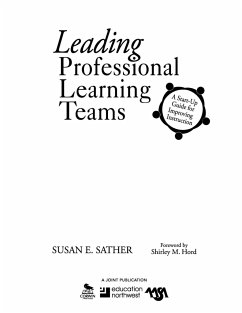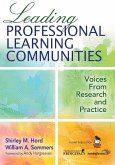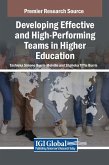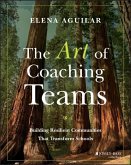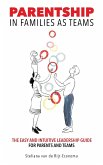- Broschiertes Buch
- Merkliste
- Auf die Merkliste
- Bewerten Bewerten
- Teilen
- Produkt teilen
- Produkterinnerung
- Produkterinnerung
Developed by Education Northwest (formerly NWREL), this guide offers a data-driven model for implementing professional learning teams to strengthen teacher collaboration, improve instruction, and increase student achievement.
Andere Kunden interessierten sich auch für
![Leading Professional Learning Communities Leading Professional Learning Communities]() Shirley M. HordLeading Professional Learning Communities34,99 €
Shirley M. HordLeading Professional Learning Communities34,99 €![Developing Effective and High-Performing Teams in Higher Education Developing Effective and High-Performing Teams in Higher Education]() Developing Effective and High-Performing Teams in Higher Education280,99 €
Developing Effective and High-Performing Teams in Higher Education280,99 €![Developing Effective and High-Performing Teams in Higher Education Developing Effective and High-Performing Teams in Higher Education]() Developing Effective and High-Performing Teams in Higher Education355,99 €
Developing Effective and High-Performing Teams in Higher Education355,99 €![Leadership Teams in America's Best Schools Leadership Teams in America's Best Schools]() Joseph F Johnson JrLeadership Teams in America's Best Schools176,99 €
Joseph F Johnson JrLeadership Teams in America's Best Schools176,99 €![The Art of Coaching Teams The Art of Coaching Teams]() Elena AguilarThe Art of Coaching Teams34,99 €
Elena AguilarThe Art of Coaching Teams34,99 €![Sustaining Creative Collaboration in Student Virtual Teams in Higher Education Sustaining Creative Collaboration in Student Virtual Teams in Higher Education]() Sustaining Creative Collaboration in Student Virtual Teams in Higher Education168,99 €
Sustaining Creative Collaboration in Student Virtual Teams in Higher Education168,99 €![Parentship In Families As Teams Parentship In Families As Teams]() Steliana van de Rijt-EconomuParentship In Families As Teams25,99 €
Steliana van de Rijt-EconomuParentship In Families As Teams25,99 €-
-
-
Developed by Education Northwest (formerly NWREL), this guide offers a data-driven model for implementing professional learning teams to strengthen teacher collaboration, improve instruction, and increase student achievement.
Produktdetails
- Produktdetails
- Verlag: Corwin
- Seitenzahl: 170
- Erscheinungstermin: 1. September 2009
- Englisch
- Abmessung: 280mm x 216mm x 9mm
- Gewicht: 445g
- ISBN-13: 9781412965538
- ISBN-10: 1412965535
- Artikelnr.: 26378503
- Herstellerkennzeichnung
- Libri GmbH
- Europaallee 1
- 36244 Bad Hersfeld
- gpsr@libri.de
- Verlag: Corwin
- Seitenzahl: 170
- Erscheinungstermin: 1. September 2009
- Englisch
- Abmessung: 280mm x 216mm x 9mm
- Gewicht: 445g
- ISBN-13: 9781412965538
- ISBN-10: 1412965535
- Artikelnr.: 26378503
- Herstellerkennzeichnung
- Libri GmbH
- Europaallee 1
- 36244 Bad Hersfeld
- gpsr@libri.de
Susan E. Sather is a senior program advisor at the Northwest Regional Educational Laboratory (NWREL) in Portland, OR. She leads the Laboratory's professional learning teams (PLT) work, supervising and conducting PLT training in schools around the nation. She also contributes to research on issues such as high school academic rigor. Sather has 38 years of experience in education, 17 as a teacher working with a dropout prevention program and in special education. Prior to joining NWREL, she was western regional manager and a staff developer for a whole-school reform model, Ventures Education Systems. She has conducted research and evaluation through the School of Education and the School of Social Welfare at the University of California Berkeley, and with ARC associates in Oakland, California. At ARC, she was a member of the Leading for Diversity research team and co-author of Leading for Diversity: How School Leaders Promote Positive Interethnic Relations. She has a PhD in educational administration from the University of California Berkeley.
List of Figures and Tables
Foreword by Shirley M. Hord
Preface
Acknowledgments
About the Author
1. Understanding Professional Learning Teams
Defining Professional Learning Teams
The Need for PLTs
Other Models for Teacher Collaboration
Key Points for Chapter 1
2. Setting the Stage for Success
Readiness for PLTs
Understanding Change
Building Relationships
Creating Avenues of Communication
Key Points for Chapter 2
3. Laying the Foundation Within the School Community
Advocating for PLTs With Important Stakeholders
Aligning With School Goals
Structures for Working Collaboratively
Providing and Using Data
Providing Additional Resources
Establishing Supportive Accountability
Key Points for Chapter 3
4. What About Leadership?
Administrators as Leaders
Shared and Facilitative Leadership
Teacher Leadership
Sustaining Leadership
Vignette: A Professional Learning Team in Action
Key Points for Chapter 4
5. Supporting the Work of PLTs
Successful PLTs
Reinforcing PLT Strategies and Skills
Ensuring That PLTs Are Teacher Led
Using a Rubric to Encourage Reflection
Anticipating Potential Challenges
Celebrating Success
Key Points for Chapter 5
Resources
A. National Staff Development Council (NSDC) Standards for Staff
Development
B. Survey of School Capacity for Continuous Improvement
C. Professional Learning Community (PLC) Survey
D. Finding Time for Professional Learning
E. Resolving Conflict: Key to Collaboration
F. Sample Conflict Scenarios
G. Possible Expectations for PLT Team Leaders and Facilitators
H. Tools
1. Professional Learning Team Inquiry Cycle
2. PLT Inquiry Cycle With Steps Explained
3. Getting Started: Sample Agenda for Workship 1
4. PLT Team Log
5. Sample PLT team Meeting Agenda and Log
6. Defining Team Roles
7. Professional Learning Team: Planning Sheet
8. Five Demensions of Professional Learning Communities
9. Criteria for Quality Team Time
10. Finding Time for Collaboration
11. Factors Supporting the Success of PLTs
12. PLT Implementation Rubric
13. Getting Started Roadmap
Suggested Readings
References
Index
Foreword by Shirley M. Hord
Preface
Acknowledgments
About the Author
1. Understanding Professional Learning Teams
Defining Professional Learning Teams
The Need for PLTs
Other Models for Teacher Collaboration
Key Points for Chapter 1
2. Setting the Stage for Success
Readiness for PLTs
Understanding Change
Building Relationships
Creating Avenues of Communication
Key Points for Chapter 2
3. Laying the Foundation Within the School Community
Advocating for PLTs With Important Stakeholders
Aligning With School Goals
Structures for Working Collaboratively
Providing and Using Data
Providing Additional Resources
Establishing Supportive Accountability
Key Points for Chapter 3
4. What About Leadership?
Administrators as Leaders
Shared and Facilitative Leadership
Teacher Leadership
Sustaining Leadership
Vignette: A Professional Learning Team in Action
Key Points for Chapter 4
5. Supporting the Work of PLTs
Successful PLTs
Reinforcing PLT Strategies and Skills
Ensuring That PLTs Are Teacher Led
Using a Rubric to Encourage Reflection
Anticipating Potential Challenges
Celebrating Success
Key Points for Chapter 5
Resources
A. National Staff Development Council (NSDC) Standards for Staff
Development
B. Survey of School Capacity for Continuous Improvement
C. Professional Learning Community (PLC) Survey
D. Finding Time for Professional Learning
E. Resolving Conflict: Key to Collaboration
F. Sample Conflict Scenarios
G. Possible Expectations for PLT Team Leaders and Facilitators
H. Tools
1. Professional Learning Team Inquiry Cycle
2. PLT Inquiry Cycle With Steps Explained
3. Getting Started: Sample Agenda for Workship 1
4. PLT Team Log
5. Sample PLT team Meeting Agenda and Log
6. Defining Team Roles
7. Professional Learning Team: Planning Sheet
8. Five Demensions of Professional Learning Communities
9. Criteria for Quality Team Time
10. Finding Time for Collaboration
11. Factors Supporting the Success of PLTs
12. PLT Implementation Rubric
13. Getting Started Roadmap
Suggested Readings
References
Index
List of Figures and Tables
Foreword by Shirley M. Hord
Preface
Acknowledgments
About the Author
1. Understanding Professional Learning Teams
Defining Professional Learning Teams
The Need for PLTs
Other Models for Teacher Collaboration
Key Points for Chapter 1
2. Setting the Stage for Success
Readiness for PLTs
Understanding Change
Building Relationships
Creating Avenues of Communication
Key Points for Chapter 2
3. Laying the Foundation Within the School Community
Advocating for PLTs With Important Stakeholders
Aligning With School Goals
Structures for Working Collaboratively
Providing and Using Data
Providing Additional Resources
Establishing Supportive Accountability
Key Points for Chapter 3
4. What About Leadership?
Administrators as Leaders
Shared and Facilitative Leadership
Teacher Leadership
Sustaining Leadership
Vignette: A Professional Learning Team in Action
Key Points for Chapter 4
5. Supporting the Work of PLTs
Successful PLTs
Reinforcing PLT Strategies and Skills
Ensuring That PLTs Are Teacher Led
Using a Rubric to Encourage Reflection
Anticipating Potential Challenges
Celebrating Success
Key Points for Chapter 5
Resources
A. National Staff Development Council (NSDC) Standards for Staff
Development
B. Survey of School Capacity for Continuous Improvement
C. Professional Learning Community (PLC) Survey
D. Finding Time for Professional Learning
E. Resolving Conflict: Key to Collaboration
F. Sample Conflict Scenarios
G. Possible Expectations for PLT Team Leaders and Facilitators
H. Tools
1. Professional Learning Team Inquiry Cycle
2. PLT Inquiry Cycle With Steps Explained
3. Getting Started: Sample Agenda for Workship 1
4. PLT Team Log
5. Sample PLT team Meeting Agenda and Log
6. Defining Team Roles
7. Professional Learning Team: Planning Sheet
8. Five Demensions of Professional Learning Communities
9. Criteria for Quality Team Time
10. Finding Time for Collaboration
11. Factors Supporting the Success of PLTs
12. PLT Implementation Rubric
13. Getting Started Roadmap
Suggested Readings
References
Index
Foreword by Shirley M. Hord
Preface
Acknowledgments
About the Author
1. Understanding Professional Learning Teams
Defining Professional Learning Teams
The Need for PLTs
Other Models for Teacher Collaboration
Key Points for Chapter 1
2. Setting the Stage for Success
Readiness for PLTs
Understanding Change
Building Relationships
Creating Avenues of Communication
Key Points for Chapter 2
3. Laying the Foundation Within the School Community
Advocating for PLTs With Important Stakeholders
Aligning With School Goals
Structures for Working Collaboratively
Providing and Using Data
Providing Additional Resources
Establishing Supportive Accountability
Key Points for Chapter 3
4. What About Leadership?
Administrators as Leaders
Shared and Facilitative Leadership
Teacher Leadership
Sustaining Leadership
Vignette: A Professional Learning Team in Action
Key Points for Chapter 4
5. Supporting the Work of PLTs
Successful PLTs
Reinforcing PLT Strategies and Skills
Ensuring That PLTs Are Teacher Led
Using a Rubric to Encourage Reflection
Anticipating Potential Challenges
Celebrating Success
Key Points for Chapter 5
Resources
A. National Staff Development Council (NSDC) Standards for Staff
Development
B. Survey of School Capacity for Continuous Improvement
C. Professional Learning Community (PLC) Survey
D. Finding Time for Professional Learning
E. Resolving Conflict: Key to Collaboration
F. Sample Conflict Scenarios
G. Possible Expectations for PLT Team Leaders and Facilitators
H. Tools
1. Professional Learning Team Inquiry Cycle
2. PLT Inquiry Cycle With Steps Explained
3. Getting Started: Sample Agenda for Workship 1
4. PLT Team Log
5. Sample PLT team Meeting Agenda and Log
6. Defining Team Roles
7. Professional Learning Team: Planning Sheet
8. Five Demensions of Professional Learning Communities
9. Criteria for Quality Team Time
10. Finding Time for Collaboration
11. Factors Supporting the Success of PLTs
12. PLT Implementation Rubric
13. Getting Started Roadmap
Suggested Readings
References
Index

